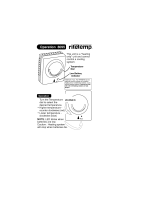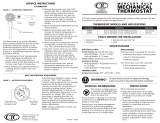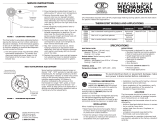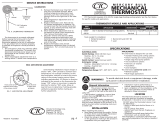
PRODUCT DATA
60-2222-3
® U.S. Registered Trademark
Copyright © 2002 Honeywell • All Rights Reserved
T87F Thermostats
APPLICATION
T87F Thermostats provide temperature control for residential
heating, cooling, or heating-cooling systems. The T87F is
designed with a dustproof spdt mercury switch, an adjustable
heat anticipator and a concealed wallplate for 2-wire heating
hookups. The Tradeline® T87F wallplate is designed for 2-
wire heating or cooling, 3-wire spdt heating (series 20), or 3-
wire spdt heating-cooling with remote switching. The wallplate
also provides cooling anticipation.
The Q539 Subbase may be added for system and fan
switching. The Q539 Subbase also provides cooling
anticipation.
FEATURES
• For 24 Vac to 30 Vac control of heating or cooling
systems.
• Thermostat cover ring may be painted to match room
decor.
• Knurled dial provides easy setpoint adjustment.
• Separate temperature setting and thermometer scale
located on face of thermostat.
• T87F distinctive style makes an attractive addition to
almost any decor.
• Enhanced setpoint visibility model available for the
visually impaired.
T87F Easy-to-
See™ Round
Model
T87F Designer
Model
T87F Standard
Model
Contents
Application.........................................................................1
Features ............................................................................1
Specifications ....................................................................2
Ordering Information .........................................................2
Installation .........................................................................3
Wiring ................................................................................4
Settings and Checkout ......................................................7
Operation...........................................................................8
Recalibration .....................................................................8

T87F THERMOSTATS
60-2222—3 2
SPECIFICATIONS
IMPORTANT
This product is tested and calibrated under closely
controlled conditions and some minor differences in
performance can be expected if those conditions are
changed. The specifications in this publication do not
include normal manufacturing tolerances; therefore,
an individual unit may not exactly match the listed
specifications.
Tradeline® Models:
For use in series 80 heating, cooling, or heating-cooling
circuit, or for use in series 20 (spdt) heating only circuit.
Tradeline® specifications are the same as those of standard
models, except as follows:
T87F Heating, Cooling, or Heating-Cooling Thermostat.
T87F Enhanced Setpoint Visibility Model for the visually
impaired.
T87F models that meet Department of Defense (DoD) Manual
4270.1-M specifications.
Model for heating. control. Locking cover, without thermome-
ter, 72°F (22°C) maximum heat.
Model for cooling control, locking cover, without thermometer,
78°F 26°C) minimum cool.
T87F with locking cover, range stops 35°F to 65°F (2°C to
18°C) range.
Temperature Ratings:
Setting Range:
Most models: 40°F to 90°F (4°C to 32°C).
Models with positive Off: 50°F to 90°F (10°C to 32°C).
Mounting:
T87F (without positive Off) furnished with 137421A Wallplate.
T87F (with positive Off) furnished with 137421B Wallplate.
Both wallplates suitable for controlling 2-wire spst heating or
cooling, 3-wire spdt heating-cooling, or 3-wire spdt series
20 heating systems.
Additional Tradeline® Features:
Cover ring included for covering old thermostat marks or for
mounting T87F on outlet box.
137421 Wallplate extends beyond thermostat for trim appear-
ance (198170A Wallplate for Designer Models).
Tradeline® pack with cross reference label and special
instruction sheet.
Standard Models:
T87F Heating, Cooling, or Heating-Cooling Thermostat. Ther-
mostat includes 104456B Wallplate for heating only sys-
tems. Order Q539 Subbase for heating-cooling.
Electrical Ratings: 1.5A at 30 Vac.
Heat Anticipator: Adjustable 0.1 to 1.2A.
Cooling Anticipator: 0 to 1.5A, 24 Vac to 30 Vac.
Temperature Ratings: 50°F to 100°F (10°C to 38°C).
Switching Action: Dust-free spdt mercury switch.
Temperature Sensing: Coiled bimetal.
Dimensions:
T87F: 3-1/4 in. (82.5 mm) diameter, 1-1/2 in. (38 mm) deep.
With 137421 Wallplate: 3-11/16 in. (93.5 mm) diameter, 1-3/4
in. (44.5 mm) deep.
With Q539 Subbase: 3-11/16 in. (93.5 mm) diameter, 1-3/4 in.
(44.5 mm) deep.
Mounting: Thermostat mounts on furnished wallplate, or sub-
base (order separately).
Finish: Premier White® or taupe.
Optional Specifications:
Positive Off Models (specify heating or cooling):
60°F to 100°F (16°C to 38°C) or 50°F to 90°F (10°C to
32°C) range.
Locking Cover and Range Stop Models:
60°F to 90°F (16°C to 32°C).
45°F to 75°F (7°C to 24°C) range, 68°F marked on scale.
Scale Range Models:
40°F to 90°F (4°C to 32°C).
45°F to 75°F (7°C to 24°C).
5°C to 30°C (67°F to 112°F).
10°C to 30°C (67°F to 86°F).
10°C to 35°C (67°F to 95°F).

T87F THERMOSTATS
3 60-2222—3
Accessories:
Q539 Subbases—provide system and fan switching and cool-
ing anticipation (unless otherwise specified) for T87F heat-
ing, cooling and heating-cooling thermostats.
TG587F1008 Thermostat Guard Key Lock Cover with window.
TG587F1016 Thermostat Guard Key Lock cover without
window.
104456B Two terminal heat only T87 Wallplate.
137421AE-T87 Taupe Wallplate with positive Off.
137421K-T87 Taupe Wallplate without positive Off.
137421R-T87 White Wallplate.
198170A Designer Beige Adapter Kit.
198172 Cover Ring for T87 Designer Beige models.
199933 Cover Ring for Taupe T87 models.
114855-00029 Cover Ring for Gold T87 models.
137421A-T87 Gold Wallplate without positive Off.
137421B-T87 Gold Wallplate with positive Off.
221886A Easy-to-Use™ Clear Ring. Durable plastic ring
snaps on Easy-to-See models.
202687A Premier White® Adapter Kit includes 6 in. cover
assembly and adapter ring to mount on outlet box or cover
marks from old thermostats.
32005439-001 Taupe Adapter Kit includes 6 in. cover assem-
bly and adapter ring to mount on outlet box or cover marks
from old thermostat.
MERCURY NOTICE
If this control is replacing a control that contains
mercury in a sealed tube, do not place your old control
in the trash. Dispose of properly.
Contact your local waste management authority for
instructions regarding recycling and the proper
disposal of an old control.
INSTALLATION
CAUTION
Voltage Hazard.
Can cause electrical shock or equipment damage.
Disconnect power before beginning installation.
CAUTION
Equipment Damage Hazard.
Improper installation can burn out thermostat heat
anticipator.
On systems using a low voltage gas valve, do not
apply a jumper across the valve coil terminals.
When Installing this Product. . .
1. Read these instructions carefully. Failure to follow them
could cause a hazardous condition.
2. Check the ratings given in the instructions and on the
product to make sure the product is suitable for your
application.
3. Installer must be a trained experienced service techni-
cian.
4. After installation is complete, check out product opera-
tion as provided in these instructions.
Location
Locate the thermostat about 5 ft (1.5m) above the floor in an
area with good air circulation at average temperature.
Do not install the thermostat where it can be affected by:
— drafts, or dead spots behind doors and in corners.
— hot or cold air from ducts.
— radiant heat from sun or appliances.
— concealed pipes and chimneys.
— unheated (uncooled) areas such as an outside wall behind
the thermostat.
This thermostat is a precision instrument and was carefully
adjusted at the factory. Handle it carefully.
Mount Wallplate or Subbase
IMPORTANT
Use a spirit level to accurately level the wallplate or
subbase as shown in Fig. 1. Inaccurate leveling may
cause the thermostat to deviate from setpoint.
When using the T87F with a Q539 Subbase, follow
the mounting and wiring instructions for the subbase.
Use the cover ring (if desired), adapter plate (if needed),
wallplate or subbase, T87F and screws as shown in Fig. 2 and
3.
IMPORTANT
Before mounting the thermostat, see Setting and
Checkout section, Heat Anticipator Adjustment sub-
section.
1. Place the cover ring on the wall at the desired location
with the cable entrance holes to the left.
NOTE: If an outlet box is used, place the cable entrance
holes toward the bottom. The side showing MADE IN
U.S.A. must be against the wall.
2. Pull the thermostat cable through the entrance hole of
the cover ring and the entrance hole of the wallplate or
subbase and adapter plate (if used).
3. Fasten the cover ring, adapter plate (if used), and the
wallplate or subbase.
4. Level the wallplate as shown in Fig. 1 and tighten the
screws.
5. After wiring the subbase or wallplate, plug the hole to
prevent interior wall drafts from affecting the thermostat.
6. Align the thermostat over the wallplate and tighten the
three captive mounting screws.

T87F THERMOSTATS
60-2222—3 4
Fig. 1. Level 104456B, 137421A,B,D Wallplates.
Fig. 2. Mount T87F, 104456B Wallplate.
Fig. 3. Mount T87F, Q539 Subbase or 137421 Wallplate to
outlet box.
WIRING
CAUTION
Voltage Hazard.
Can cause electrical shock or equipment damage.
Disconnect power before beginning installation.
IMPORTANT
All wiring must comply with local electrical codes and
ordinances.
The T87F may be used in most 2- or 3-wire, spst or spdt, 24
Vac to 30 Vac heating systems controlled by a low voltage
thermostat. The following wiring diagrams represent typical
applications.
SPIRIT
LEVEL
LEVELING
POSTS (2)
MOUNTING
SLOTS
SPIRIT LEVEL
104456B WALLPLATE
1
37421A,B,D WALLPLATE
MOUNTING
SLOTS
BE SURE WAL
L
HOLE IS
PLUGGED
MOUNTING
SLOTS
TERMINAL
SCREWS
M20772
OPENING FOR
THERMOSTAT
WIRING
T87F
THERMOSTAT
COVER RING
M2077
3
THERMOSTA
T
COVER RING
MOUNTING
SLOTS (4)
THERMOSTAT
CABLE OPENING
104456B WALLPLATE
OUTLET BOX
127293
COVER RING
Q539 SUBBASE
M2077
4
THERMOSTAT
CABLE
ENTRANCE
HOLES
137421
WALLPLATE
CAPTIVE
MOUNTING
SCREWS (3)
T87F
1
1
2
2
IF OUTLET BOX IS HORIZONTAL, MOUNT COVER RING IN POSITIO
N
SHOWN, BUT FASTEN WITH SCREWS THROUGH "A".
USE 137421A,B WALLPLATE FOR HEAT OR COOL APPLICATIONS
WITHOUT SWITCHING. USE Q539 SUBBASE FOR HEAT OR COOL
APPLICATIONS WITH SWITCHING.

T87F THERMOSTATS
5 60-2222—3
Fig. 4. Internal wiring for T87F Heating Only Thermostat.
Fig. 5. Internal wiring for T87F Cooling Only Thermostat.
Fig. 6. Internal wiring for Tradeline® T87F Thermostat.
Fig. 7. Typical wiring for T87F used as a Cooling Only
Thermostat.
TEMPERATURE FALL
ADJUSTABLE
HEAT
ANTICIPATOR
R1
R
Y1
W1
W
1
3
2
1
2
3
T87F
THERMOSTA
T
104456B
WALLPLATE
TO SYSTEM CONNECTIONS
HEATING ONLY THERMOSTAT
MODEL WITH POSITIVE OFF SWITCH OPENS THE THERMOSTAT CIRCUIT
WHEN SETPOINT DIAL IS MOVED TO THE OFF POSITION.
MAKE SYSTEM WIRING CONNECTIONS TO TERMINALS ON 104456B
WALLPLATE.
R1, W1 TERMINALS ON THERMOSTAT ARE DIRECTLY CONNECTED TO
R, W TERMINALS ON WALLPLATE WHEN THERMOSTAT IS MOUNTED
ON WALLPLATE.
M18011
TEMPERATURE RISE
R1
R
Y1
W1
Y
1
3
2
1
2
3
T87F
THERMOSTA
T
137421D
WALLPLATE
COOLING
ANTICIPATOR
TO SYSTEM CONNECTIONS
COOLING ONLY THERMOSTAT
MODEL WITH POSITIVE OFF SWITCH OPENS THE THERMOSTAT
CIRCUIT WHEN SETPOINT DIAL IS MOVED TO THE OFF POSITION.
MAKE SYSTEM WIRING CONNECTIONS TO TERMINALS ON 137421D
WALLPLATE.
R1, W1 TERMINALS ON THERMOSTAT ARE DIRECTLY CONNECTED TO
R, Y TERMINALS ON WALLPLATE WHEN THERMOSTAT IS MOUNTED
ON WALLPLATE.
M20775
TEMPERATURE FALL
ADJUSTABLE
HEAT
ANTICIPATOR
COOLING
ANTICIPATOR
R1
R
Y1
W1
W
1
3
2
1
2
3
T87F
THERMOSTAT
137421A,B
WALLPLATE
TO SYSTEM CONNECTIONS
TRADELINE THERMOSTAT
MODEL WITH POSITIVE OFF SWITCH OPENS THE THERMOSTAT
CIRCUIT WHEN SETPOINT DIAL IS MOVED TO THE OFF POSITION.
MAKE SYSTEM WIRING CONNECTIONS TO TERMINALS ON 137421A,B
WALLPLATE.
R1, W1, Y1 TERMINALS ON THERMOSTAT ARE DIRECTLY CONNECTED T
O
R, W, Y TERMINALS ON WALLPLATE WHEN THERMOSTAT IS MOUNTED
ON WALLPLATE.
Y
M20776
1
L1
(HOT
)
L2
1
THERMOSTAT
COOLING
CONTACTOR COIL
POWER SUPPLY. PROVIDE DISCONNECT MEANS AND
OVERLOAD PROTECTION AS REQUIRED.
M610
1
R
Y

T87F THERMOSTATS
60-2222—3 6
Fig. 8. T87F in typical oil heating system.
Fig. 9. T87F in typical gas heating system.
Fig. 10. T87F in heating-cooling application with remote
mounted system changeover switch. (Use Q539 Subbase
for switching at thermostat location.)
To Replace a Series 10 Thermostat
To adapt the T87F to a series 10 three-wire heating system:
1. Connect the wires from the thermostat (R and W) to the
terminals on the three-wire primary (B and W). See Fig.
11 and 12.
NOTES:
— Some three-wire controls manufactured by other
companies cannot be satisfactorily operated by a
two-wire thermostat.
— Before connecting the T87F to a three-wire con-
trol, consult the manufacturer.
— Some Honeywell series 10 relays require an R-B
jumper (see Fig. 11). These relays are:
R114A,B R125 R117 R187A1,A4
R116 R126 R178 R190B1,B8
R117 R161 R180
— Relays or valves that do not require a jumper may
retain a three-wire, low limit control as shown in
Fig. 11. If the jumper is required, a two-wire con-
trol must be used.
— A three-wire, open contact, high-limit control
requires a jumper as shown in Fig. 12.
Fig. 11. T87F (replacing a series 10 thermostat) connected
to a 2- or 3-wire low limit control.
L2
COMBINATION FAN
AND LIMIT CONTROL
FAN
MOTOR
BURNER
MOTOR
THERMOSTAT
Y
R
W
CAD CELL
1
2
3
R8184G
WHITE
ORANGE
BLACK
IGNITION
OIL VALVE
POWER SUPPLY. PROVIDE DISCONNECT MEANS AND
OVERLOAD PROTECTION AS REQUIRED.
R8184 PROTECTORELAY OIL PRIMARY CONTAINS
INTERNAL TRANSFORMER
CONNECT OIL VALVE, IF APPLICABLE.
2
1
T
F
M6105
A
T
F
L1
(HOT)
3
R
W
1
L1
(HOT
)
L2
FAN
MOTOR
COMBINATION FAN AND
LIGHT CONTROLLER
LIMIT
FAN
TRANSFORMER
GAS VALVE
THERMOSTAT
TH
TH
TR
TR
M6103
1
POWER SUPPLY. PROVIDE DISCONNECT MEANS AND
OVERLOAD PROTECTION AS REQUIRED.
L1
(HOT
)
L2
TRANSFORMER
THERMOSTAT
M6104A
1
1
POWER SUPPLY. PROVIDE DISCONNECT MEANS AND OVERLOAD
PROTECTION AS REQUIRED.
R
Y
W
COOLING
CONTACTOR COIL
ISOLATING
RELAY
HEAT
POSITION
REMOTE
CHANGEOVER
SWITCH
OIL PRIMARY
COOL
POSITION
2-WIRE LOW LIMIT
OPERATING CONTROL
JUMPER
MAY BE
REQUIRED
T87F
SERIES 10
RELAY OR VALVE
3-WIRE LOW-LIMIT OPERATING
CONTROL MAY BE RETAINED
ONLY IF R-B JUMPER IS NOT
REQUIRED ON RELAY OR VALVE
M2077
7
Y
R
W
R
R
B
B
W
W
W
B
R

T87F THERMOSTATS
7 60-2222—3
Fig. 12. T87F (replacing a series 10 thermostat) connected
to a 3-wire open contact, high-limit control.
To Replace a Series 20 Thermostat
Tradeline® T87F Thermostats directly replace series 20 spdt
thermostats, or thermostats in heating installations that
require contact on both a rise and fall in temperature (see Fig.
13).
Fig. 13. Tradeline® T87F in Series 20 Heating Circuit.
To wire a series 20 thermostat:
SETTINGS AND CHECKOUT
Temperature Selection
To select the desired temperature, turn the transparent dial
until the desired point on the setting scale (top scale) is in line
with the pointer.
On models with range stops the temperature range may be
limited at either extreme. The left stop is for the low extreme,
the right stop for the high extreme (see Fig. 14).
Heat Anticipator Adjustment
The thermostat has an adjustable heat anticipator that must
be set on the number that corresponds to the current rating of
the primary control of the system (for example; gas valve, oil
primary).
Fig. 14. T87F interior detail.
Fig. 15. Adjust heat anticipator to match current rating of
primary control.
Series 20 Thermostat T87F Thermostat
RR
BW
WY
LOW LIMIT
OPERATING CONTROL
T87F
SERIES 10 OPEN
CIRCUIT HIGH LIMIT
JUMPER
TO THERMOSTAT
CONNECTIONS ON
SERIES 10 VALVE
AT BURNER
M6102
B
W
R
Y
R
W
B
W
R
137421A
WALLPLATE
SERIES 20
MOTOR OR VALVE
LEVEL LEVEL
TRANSFORMER
L1
(HOT)
L2
M2077
8
R B W
Y
R
W
TR TR
POWER SUPPLY. PROVIDE DISCONNECT MEANS AND
OVERLOAD PROTECTION AS REQUIRED.
MAKE CONNECTIONS AS SHOWN: R TO R, W TO B, Y TO W.
1
2
1
2
CAPTIVE
MOUNTING
SCREW (3)
HEAT ANTICIPATOR INDICATOR
ROOM TEMPERATURE SCAL
E
M19049
CALIBRATION NUT
SETTING SCALE
ADJUSTABLE RANGE
STOPS ON SOME MODELS
.15
.12
.2
.6
.8
1.0
.5
.4
.3
HOLE SUITABLE FOR
PENCIL POINT
TO MOVE INDICATOR
HEAT
ANTICIPATOR
INDICATOR
S
CALE
M1368
A

T87F THERMOSTATS
60-2222—3 G.H. Rev. 8-02 www.honeywell.com/yourhome
Automation and Control Solutions
Honeywell Honeywell Limited-Honeywell Limitée
1985 Douglas Drive North 35 Dynamic Drive
Golden Valley, MN 55422 Scarborough, Ontario
M1V 4Z9
Printed in U.S.A. on recycled
paper containing at least 10%
post-consumer paper fibers.
IMPORTANT
When the T87F is used in a series 20 heating circuit
(requires contact on both a rise and fall in tempera-
ture), set the anticipator indicator to 1.2.
If the current rating is not known, proceed as follows:
1. Connect an ac ammeter of appropriate range (for exam-
ple; 0 to 2A) between the R and W terminals on the
wallplate, or between R and W on the subbase.
2. Let the system operate through the ammeter for at least
one minute before taking the reading.
3. Set the heat anticipator to correspond to the ammeter
reading (see Fig. 15).
4. A slightly higher setting to obtain longer burner-on times
(and fewer cycles per hour) may be desirable in sys-
tems such as a one-pipe steam system. For example:
• if burner on-time is too short with a heater setting of
0.4, adjust to the 0.45 setting and check the system
operation, then
• adjust to the 0.5 setting and recheck until the desired
burner-on time is obtained.
OPERATION
CAUTION
Equipment Damage Hazard.
Improper installation can burn out thermostat heat
anticipator.
On systems using a low voltage gas valve, do not
apply a jumper across the valve coil terminals.
To check thermostat operation:
1. Turn down the temperature setting to the lowest point.
2. If the subbase is used, move the system switch to the
HEAT position.
3. Raise the temperature setting until the burner starts.
4. Slowly turn the dial back. (The burner should stop when
the dial has been turned down below the room tempera-
ture.)
5. If the T87F controls cooling, move the subbase system
switch (if used) to COOL and lower the setting until the
cooling equipment starts.
6. Raise the setting above the room temperature and the
cooling system should shut down.
7. Make certain that the equipment functions properly in
response to the thermostat.
RECALIBRATION
IMPORTANT
— If the thermostat scaleplate moves (pointer is station-
ary) when setting the temperature, the thermostat is
a Group I model.
— If the scaleplate is stationary and the pointer moves,
the thermostat is a Group II model.
The T87F is accurately calibrated at the factory under
controlled conditions and no recalibration should be
necessary. If it appears that the thermostat is out of
calibration, make sure that it is level and is not subjected to
radiant heat from the sun, radiators, or appliances.
Remove the thermostat cover ring so you can observe the
mercury switch action. After a five- or ten-minute off-period
(with thermostat setting below the room temperature), slowly
raise the setting until the switch just makes contact. If the
thermometer pointer and setting indicator read the same the
instant you see the switch make, no recalibration is
necessary. If recalibration is necessary, proceed as follows:
1. Turn the setting dial a few degrees above the room tem-
perature and remove the cover.
2. Slip the 104994 Calibration Wrench (available on
request) onto the hex under the bimetal coil (see Fig.
14).
3. Hold the dial firmly, and turn the hex counterclockwise
for Group I models and clockwise for Group II models,
until the mercury breaks contact.
4. Turn the dial to a low setting so that the thermostat
loses the heat it has gained from your hands and its
own operation.
5. Wait at least five minutes.
6. Slowly turn the dial until the pointers read the same.
7. Firmly hold the dial—carefully turning the hex clockwise
for Group I models, counterclockwise for Group II mod-
els—until the mercury switch slips to the heating contact
end of the tube.
8. Recheck the calibration, select the desired temperature
and replace the cover.
NOTE: When the T87F provides cooling control, calibration
for heating automatically calibrates for cooling.
-
 1
1
-
 2
2
-
 3
3
-
 4
4
-
 5
5
-
 6
6
-
 7
7
-
 8
8
Ask a question and I''ll find the answer in the document
Finding information in a document is now easier with AI
Related papers
-
Honeywell CT50A User manual
-
Honeywell Q539G User manual
-
Honeywell R8184G4009 User manual
-
Honeywell CT1802 User manual
-
Honeywell Round CT87B User manual
-
Honeywell T8400C User manual
-
Honeywell T822C User manual
-
Honeywell Q539A Installation Instructions Manual
-
Honeywell EASY-TO-SEE T841B User manual
-
Honeywell T8090A User manual
Other documents
-
ClimateMaster ATM11H05S and ASUB05 Install Manual
-
 RiteTemp 8095 Operating instructions
RiteTemp 8095 Operating instructions
-
King Electric HET-2R User guide
-
 Hunter Fan 43320 Owner's manual
Hunter Fan 43320 Owner's manual
-
White Rodgers Type 1E56 User manual
-
Lux Products T20-1141 Owner's manual
-
 Hunter Fan 43302 Owner's manual
Hunter Fan 43302 Owner's manual
-
Lux Products T10-1141 Owner's manual
-
 Hunter Fan 43007 User manual
Hunter Fan 43007 User manual
-
White Rodgers 1F56W-911 User manual











